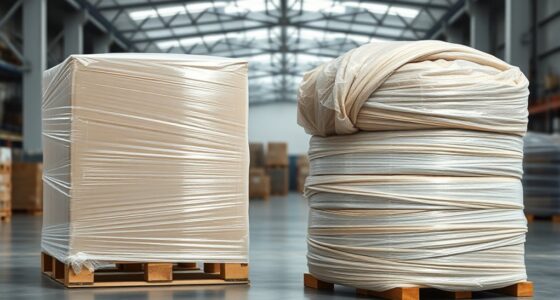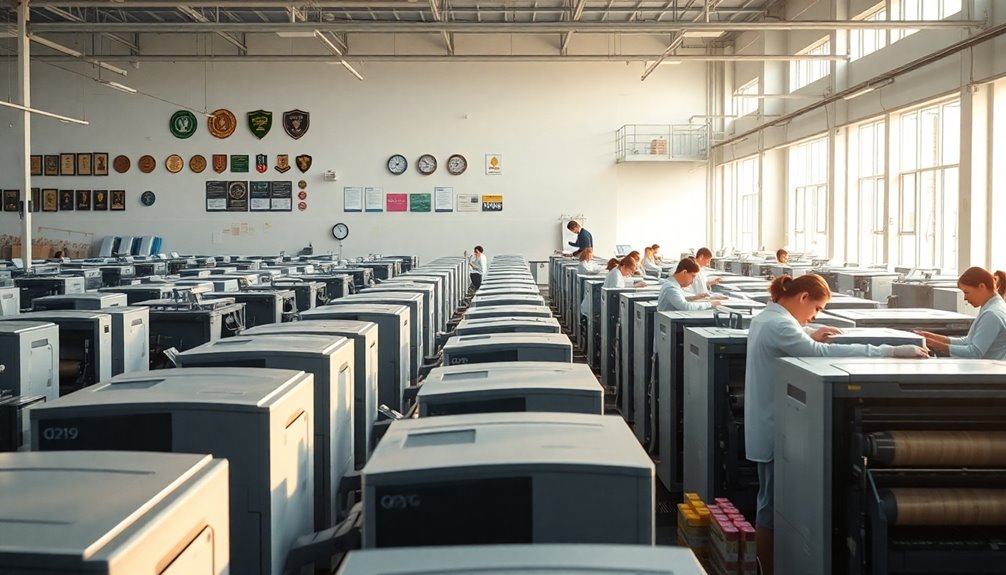Choosing between film packaging and rigid packaging depends on your product’s needs. Film packaging offers lightweight protection, customization, and eco-friendly options that can lower costs and shipping impact. Rigid packaging provides durability, a premium feel, and better protection for fragile or heavy items, though it may increase transportation costs. Each option has its pros and cons. To find out which fits your goals best, explore the specific benefits and trade-offs further.
Key Takeaways
- Film packaging offers lightweight, cost-effective, and versatile solutions with eco-friendly options, suitable for a wide range of products.
- Rigid packaging provides superior protection, durability, and a premium appearance, ideal for fragile or high-value items.
- Film packaging reduces transportation costs due to lower weight, while rigid packaging increases shipping expenses but enhances product safety.
- Eco-conscious choices include biodegradable film and recycled rigid materials, affecting overall sustainability impact.
- The decision depends on product fragility, brand image, logistics, and sustainability priorities.

Choosing the right packaging option can considerably impact product protection, cost, and customer appeal. When deciding between film and rigid packaging, it’s important to contemplate how each choice aligns with your goals for sustainability impact and cost efficiency. Film packaging, often made from flexible plastics like polyethylene or polypropylene, offers a lightweight and versatile solution that can significantly reduce shipping costs. Its low weight means less fuel consumption during transportation, contributing positively to your sustainability impact. Additionally, film packaging generally requires less material than rigid options, which further enhances its cost efficiency. You can often achieve a snug, customized fit for various products, minimizing waste and optimizing material use. Moreover, innovative film materials with enhanced barrier properties can extend product shelf life, reducing waste and supporting sustainability goals.
Choosing flexible, lightweight film packaging can reduce costs and environmental impact through optimized material use.
On the other hand, rigid packaging, such as plastic containers, boxes, or clamshells, provides superior durability and product protection, especially for fragile or heavy goods. While rigid options might involve higher upfront material costs, they can sometimes offer better long-term value by reducing product damage and returns. This durability can also influence the sustainability impact positively if it results in fewer replacements or waste. However, rigid packaging tends to be heavier and uses more material, which can increase transportation costs and carbon footprint—factors that may offset some of its protective advantages. When evaluating cost efficiency, you should assess whether the added protection and customer perception justify the higher material and shipping expenses.
The choice also hinges on your product’s nature and your brand image. Film packaging’s sleek, transparent appearance appeals to consumers seeking minimalistic, eco-friendly options, especially if you choose biodegradable or recyclable films. Rigid packaging, meanwhile, can lend a premium feel and greater sturdiness, which might resonate with customers looking for high-quality, durable products. From a sustainability impact perspective, it’s vital to contemplate the lifecycle of your packaging materials. Opting for recyclable films or incorporating eco-friendly materials can help mitigate environmental concerns associated with film packaging. Conversely, choosing rigid packaging made from recycled plastics can also lessen your overall environmental footprint.
Ultimately, balancing cost efficiency with sustainability impact requires a clear understanding of your product, customer preferences, and supply chain logistics. If reducing costs and environmental footprint is a priority, film packaging might be the better option, especially if you can source eco-friendly variants. If product protection, brand perception, and durability matter most, rigid packaging could serve you better despite higher initial costs. Additionally, considering material sustainability and the recyclability of your chosen packaging can further enhance your environmental impact. Whichever route you choose, consider how each packaging type aligns with your business values and operational goals to make the most effective decision for your brand’s success.
Frequently Asked Questions
How Do Environmental Impacts Differ Between Film and Rigid Packaging?
You’ll find that film packaging generally has higher recycling rates because it’s lighter and easier to process, reducing waste and energy use. Rigid packaging, often made from thicker materials, might be more durable but can be less eco-friendly due to higher material sourcing impacts. Both types impact the environment, but film packaging often results in lower carbon footprints, especially when recycled efficiently.
Which Packaging Type Offers Better Protection for Fragile Products?
Think of packaging as a guardian for your fragile products. Rigid packaging acts like a sturdy shield, offering superior fragility protection and cushioning effectiveness, especially for delicate items. It absorbs shocks better and maintains shape, reducing breakage risks. Film packaging, while flexible and lightweight, doesn’t provide the same level of protection. If safeguarding fragile products is your priority, rigid packaging is your best bet for dependable cushioning.
What Are the Cost Differences Over the Product Lifecycle?
You’ll find that film packaging generally has lower initial costs, but rigid packaging tends to have higher lifecycle expenses due to material durability and reusability. Conducting a thorough cost analysis helps you compare these options over the product lifecycle, considering factors like transportation, storage, and waste management. While film is cheaper upfront, rigid packaging might save money long-term by reducing damage and replacement costs, making it a better investment depending on your product needs.
How Do Consumer Preferences Influence Packaging Choices?
Consumer choices chase clarity, comfort, and convenience, shaping packaging preferences profoundly. Your audience’s behavior biases branding strategies, pushing you to prioritize appealing aesthetics and eco-friendly options. You notice that sleek, sustainable packaging attracts attention and builds trust, influencing purchasing decisions. By understanding these evolving consumer preferences, you can tailor your packaging to boost brand loyalty, improve product perception, and stay ahead in a competitive market.
Are There Specific Industries That Favor One Packaging Type Over the Other?
You’ll find that certain industries prefer specific packaging types based on industry-specific packaging needs and regional packaging preferences. For example, food and beverage industries often choose film packaging for its flexibility and freshness, while electronics favor rigid packaging for protection. Regional preferences also influence choices; some areas prefer eco-friendly options, impacting whether companies opt for film or rigid packaging. Your choice depends on balancing protection, sustainability, and consumer expectations.
Conclusion
So, whether you choose film or rigid packaging, think about what suits your product best. Film offers flexibility and lightweight convenience, like a swift dance move. Rigid packaging provides sturdy protection, much like a reliable handshake. Both options serve different needs—one’s sleek and adaptable, the other’s strong and dependable. Ultimately, your choice balances practicality with presentation, proving that sometimes, the best packaging isn’t about one or the other, but how well they complement your product’s story.









